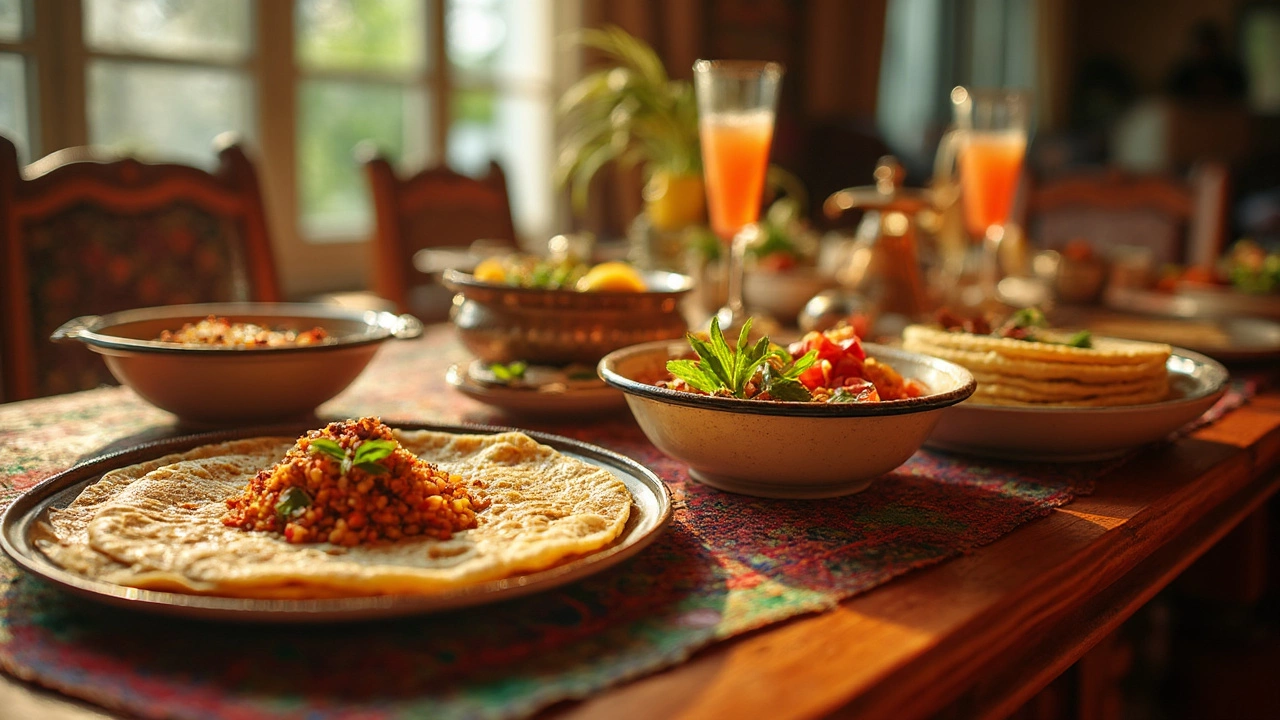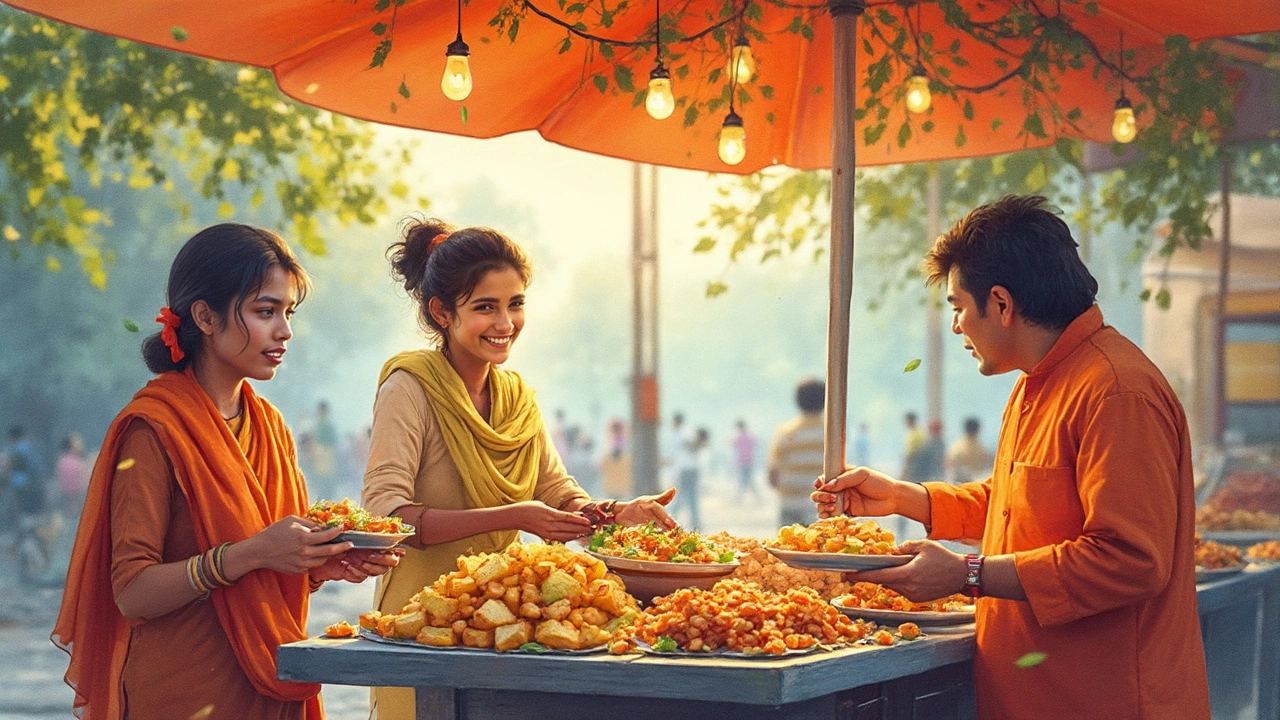Fancy some Indian snacks without the calorie guilt trip? Good news: Indian cuisine isn't all about buttery curries and deep-fried goodness. There's a whole vibrant world of flavors that doesn't weigh down your health goals. You just need to know where to look—or maybe what to cook.
Take idli, for instance. This soft and fluffy rice cake hails from South India and is naturally low in calories. It's steamed, not fried, which is a big win for your waistline. Pair it with some spicy sambar or coconut chutney, and it hits the spot without being a calorie bomb.
Bhel puri is another snack that ticks the 'light' box. It's a tangy, savory mix of puffed rice, vegetables, and tangy sauces. The trick is to go easy on the chutneys and not get carried away with the sev—a crispy topping made from chickpea flour. You can whip it up at home, making it easier to control what goes in. Enjoying Indian flavors doesn’t have to mean loading up on fats.
- Understanding Indian Cuisine
- Smart Choices: Least Fattening Dishes
- Benefits of Light Indian Snacks
- Cooking Tips for Healthier Indian Dishes
- Why Flavor Doesn't Mean Fat
Understanding Indian Cuisine
Diving into Indian cuisine is like stepping into a vibrant spice market—it's all about variety and flavor. What sets Indian food apart is the rich tapestry of ingredients and cooking styles. From the north to the south, east to west, each region brings its own flair, making every dish a unique experience.
Indian cuisine is a delicious blend of legumes, grains, vegetables, and spices. It's about the balance of flavors, and contrary to the idea of it being heavy, many dishes are naturally light and nutritious. Take traditional dishes like dal, which is rich in protein and easy on the oil, or the various forms of roti, a simple unleavened bread made from whole wheat flour.
Spices are the heart of Indian cooking. Turmeric, cumin, coriander, and mustard seeds aren't just there for taste; they pack a health punch, too. Turmeric, known for its anti-inflammatory properties, is added to many dishes. It not only enhances the golden color but also offers health benefits that make Indian food a natural comfort for the body.
Often, Indian snacks are seen as calorie-laden, but that's not always the case. A dish doesn't have to be dripping in ghee to be tasty. Many options, like simple grilled tandoori chicken or spiced chaats, fit perfectly into a healthy lifestyle.
Healthy Indian dishes are often about smart preparation—you know, steaming instead of frying. Plus, the use of fresh herbs like cilantro and mint can elevate a dish's flavor without extra calories.
Not everything Indian is about overwhelming flavors or fiery spices, either. Mild yet fragrant dishes, such as lemon rice or vegetable soup with Indian spices, show how subtlety has a place at the table. It's all about understanding how to make the most out of each ingredient while still keeping it light on the waistline.
Smart Choices: Least Fattening Dishes
When it comes to picking healthy Indian snacks that are kind to your waistline, it's all about choosing the right ingredients and cooking methods. One brilliant option is the classic dhal. This lentil-based dish is usually made with spices such as turmeric, cumin, and mustard seeds, which pack a punch without packing on the pounds. Lentils are naturally low in fat while being rich in protein and fiber. They're like the unsung heroes of Indian cuisine.
If you're in the mood for something a little different, give sambar a whirl. It's a spicy vegetable stew that's typically served with idli or dosa. The great thing about sambar is its versatility—feel free to toss in whatever veggies you have. It's like your fridge's best friend! Make sure to keep the oil content low to keep the dish light and healthy.
And let's not forget about the incredible chana salad. Made with chickpeas, tomatoes, cucumbers, and a dash of lime juice, this salad is refreshing and filling. Chickpeas are high in protein and fiber, making this salad a super satisfying option. It’s a great way to keep those hunger pangs at bay without chomping on unhealthy snacks.
- Bhel Puri: A savory mix of puffed rice, vegetables, and tangy chutneys. Go light on the sev to keep it least fattening.
- Moong Dal Chilla: A simple pancake made of mung beans that offers a protein boost without extra calories.
- Buttermilk: This refreshing cooled drink is low in calories and a wonderful choice instead of sugary sodas.
Remember, the key is to get creative in the kitchen. By making mindful choices and opting for steaming, boiling, or grilling over frying, you can enjoy all the deliciousness Indian snacks have to offer without any post-snack guilt!

Benefits of Light Indian Snacks
Alright, let's talk about why choosing light Indian snacks is not just a smart move for your taste buds but also for your overall health. First off, many Indian snacks are naturally packed with nutrients. Take dhokla, a fluffy, fermented snack made from gram flour. It's not only low in calories but also a good source of protein and probiotics, which are great for your gut health.
These lighter options are usually steamed or baked, which means you're keeping those unnecessary oils at bay. This method helps retain more nutrients compared to deep-frying. Plus, they're often made with lentils and grains, offering a hearty dose of fiber. Fiber is your friend because it keeps you full longer, trimming down those snack-time shenanigans that lead to overeating.
But wait, there's more. Light Indian dishes often feature a variety of spices like turmeric, ginger, and cumin that don't just serve up bold flavors. They also come with health perks. Turmeric's active compound, curcumin, has anti-inflammatory properties. Ginger aids digestion, and cumin can work wonders for your metabolism. So you're getting a meal that's both tasty and health-boosting.
When choosing these healthier options, many find a handy balance between indulging cravings and maintaining dietary goals. And because traditional Indian cuisine is typically apt for modifications, you can make easy swaps like using less oil or opting for whole-grain flours, keeping meals light yet satisfying.
Cooking Tips for Healthier Indian Dishes
Cooking healthier versions of your favorite Indian snacks at home can be a game-changer for your diet. You get to enjoy all those awesome flavors without worrying about extra calories sneaking onto your plate. Here's how you can start making smarter choices in your Indian cooking.
First off, consider steaming or baking instead of frying. While traditionally a deep-fried favorite, samosas can be made healthier by baking them. Trust me, the crunchy exterior is still there, minus the fat. And when it comes to veggies, steam them instead of sautéing in oil for a lighter, fresher taste.
Spices are your new best friend. They add flavor without the fat. Think along the lines of turmeric, cumin, coriander, and garlic. These not only amp up the taste but also offer health benefits. For sweetness, try using jaggery or honey instead of refined sugar. These alternatives give a deeper flavor while being slightly better for you.
Switch up your ingredients: whole grains and legumes are stars here. Opt for whole wheat chapati instead of naan. It's just as tasty and more nutritious. Lentils, beans, and chickpeas are great fillers for curries and make them hearty without needing loads of oil or butter.
- Use non-stick cookware to reduce the amount of oil needed for cooking.
- Try low-fat yogurt or coconut milk as a base for creamy dishes.
- Maximize the use of herbs like cilantro and mint to refresh dishes without adding calories.
If you're up for it, try making your own spice blends. You'll skip the sodium and preservatives found in store-bought options, plus you can adjust the heat to your palette's liking.

Why Flavor Doesn't Mean Fat
Sometimes we think that for a dish to taste amazing, it must be drowning in oil or butter. But in Indian cuisine, you can savor rich flavors without the extra calories tagging along. It all comes down to smart ingredient choices and cooking methods.
Spices are the secret superheroes in Indian cuisine. You’ve got turmeric, cumin, coriander, and cardamom, and the list could go on forever. These not only ramp up the taste but also come with health perks like reducing inflammation or aiding digestion. And guess what? They add zero calories!
Another trick is swapping ingredients. Using low-fat yogurt instead of cream in curry gives you a creamy texture without the fat. Or try grilling or steaming veggies instead of frying them. These small changes really help keep dishes light.
Here’s a quick tip: When cooking, always opt for fresh ingredients over processed ones. This not only boosts the taste but is also a win for your health. And you control how much salt and sugar go into your food, unlike pre-packaged meals.
If you ever needed proof that flavor and health can go hand in hand, here it is. A spicy lentil soup, known as dal, not only warms your soul but also fuels your body with protein and fiber without a single gram of fat.
Here's a simple table to explain how different cooking methods impact calorie count:
| Cooking Method | Calorie Impact |
|---|---|
| Steaming | Preserves nutrients, keeps calories low |
| Grilling | Enhances flavor, reduces fat |
| Frying | Increases calorie count significantly |
By choosing how you cook and spice your food, you can keep enjoying Indian snacks that are both comforting and healthy. So the next time you're craving something bursting with taste, remember it doesn’t have to mean fat by default.
